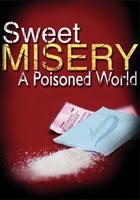Looks like a puppet show for the next false flag mass poisoning and a handy excuse to shut down the press. See the recent movie "Contagion" and you'll discover an ending that is about as scientifically feasible as the film "Reefer Madness".
New York Times
Dennis Grady
William J. Broad
For the first time ever, a government advisory board is asking scientific journals not to publish details of certain biomedical experiments, for fear that the information could be used by terrorists to create deadly viruses and touch off epidemics.
The A(H5N1) virus largely affects birds and rarely infects people, but it is highly deadly when it does.
In the experiments, conducted in the United States and the Netherlands, scientists created a highly transmissible form of a deadly flu virus that does not normally spread from person to person. It was an ominous step, because easy transmission can lead the virus to spread all over the world. The work was done in ferrets, which are considered a good model for predicting what flu viruses will do in people.
The virus, A(H5N1), causes bird flu, which rarely infects people but has an extraordinarily high death rate when it does. Since the virus was first detected in 1997, about 600 people have contracted it, and more than half have died. Nearly all have caught it from birds, and most cases have been in Asia. Scientists have watched the virus, worrying that if it developed the ability to spread easily from person to person, it could create one of the deadliest pandemics ever.
A government advisory panel, the National Science Advisory Board for Biosecurity, overseen by the National Institutes of Health, has asked two journals, Science and Nature, to keep certain details out of reports that they intend to publish on the research. The panel said conclusions should be published, but not “experimental details and mutation data that would enable replication of the experiments.”
The panel cannot force the journals to censor their articles, but the editor of Science, Bruce Alberts, said the journal was taking the recommendations seriously and would probably withhold some information — but only if the government creates a system to provide the missing information to legitimate scientists worldwide who need it.
The journals, the panel, researchers and government officials have been grappling with the findings for several months. The Dutch researchers presented their work at a virology conference in Malta in September.
Scientists and journal editors are generally adamant about protecting the free flow of ideas and information, and ready to fight anything that hints at censorship.
“I wouldn’t call this censorship,” Dr. Alberts said. “This is trying to avoid inappropriate censorship. It’s the scientific community trying to step out front and be responsible.”
He said there was legitimate cause for the concern about the researchers’ techniques falling into the wrong hands.
“This finding shows it’s much easier to evolve this virus to an extremely dangerous state where it can be transmitted in aerosols than anybody had recognized,” he said. Transmission by aerosols means the virus can be spread through the air via coughing or sneezing.
Ever since the tightening of security after the terrorist attacks on Sept. 11, 2001, scientists have worried that a scientific development would pit the need for safety against the need to share information. Now, it seems, that day has come.
“It’s a precedent-setting moment, and we need to be careful about the precedent we set,” Dr. Alberts said.
Both studies of the virus — one at the Erasmus Medical Center in Rotterdam, in the Netherlands, and the other at the University of Wisconsin-Madison — were paid for by the National Institutes of Health. The idea behind the research was to try to find out what genetic changes might make the virus easier to transmit. That way, scientists would know how to identify changes in the naturally occurring virus that might be warning signals that it was developing pandemic potential. It was also hoped that the research might lead to better treatments.
Dr. Anthony Fauci, head of the National Institute of Allergy and Infectious Diseases, said the research addressed important public health questions, but added, “I’m sure there will be some people who say these experiments never should have been done.”
Dr. Fauci said staff members at the institutes followed the results of the research and flagged it as something that the biosecurity panel should evaluate.
The lead researcher at the Erasmus center, Ron Fouchier, did not respond to requests for an interview. The center issued a statement saying that researchers there had reservations about the panel’s recommendation, but would observe it.
The Wisconsin researcher, Yoshihiro Kawaoka, was out of the country and “not responding to queries,” according to a spokesman for the university. But the school said its researchers would “respect” the panel’s recommendations.
“My concern is that we don’t give amateurs — or terrorists — information that might let them do something that could really cause a lot a harm,” he said in an interview.
“It’s a wake-up call,” Dr. Franz added. “We need to make sure that our best and most responsible scientists have the information they need to prepare us for whatever we might face.”
Amy Patterson, director of the office of biotechnology activities at the National Institutes of Health, in Bethesda, Md., said the recommendations were a first.
“The board in the past has reviewed manuscripts but never before concluded that communications should be restricted in any way,” she said in a telephone interview. “These two bodies of work stress the importance of public health preparedness to monitor this virus.”
Ronald M. Atlas, a microbiologist at the University of Louisville and past president of the American Society for Microbiology, who has advised the federal government on issues of germ terrorism, said the hard part of the recommendations would be creating a way to move forward in the research with a restricted set of responsible scientists.
He said that if researchers had a better understanding of how the virus works, they could develop better ways to treat and prevent illness. “That’s why the research is done,” he said.
The government, Dr. Atlas added, “is going to struggle with how to get the information out to the right people and still have a barrier” to wide sharing and inadvertently aiding a terrorist. “That’s going to be hard.”
Given that some of the information has already been presented openly at scientific meetings, and that articles about it have been sent out to other researchers for review, experts acknowledged that it may not be possible to keep a lid on the potentially dangerous details.
“But I think there will be a culture of responsibility here,” Dr. Fauci said. “At least I hope there will.”
The establishment of the board grew out of widespread fears stemming from the 2001 terrorist attacks on the United States and the ensuing strikes with deadly anthrax germs that killed or sickened 22 Americans.
The Bush administration called for wide controls on biological information that could potentially help terrorists. And the scientific community firmly resisted, arguing that the best defenses came with the open flow of information.
In 2002, Dr. Atlas, then the president-elect of the American Society for Microbiology, objected publicly to “anything that smacked of censorship.”
The federal board was established in 2004 as a compromise and is strictly advisory. It has 25 voting members appointed by the secretary of health and human services, and has 18 ex officio members from other federal agencies.
Federal officials said Tuesday that the board has discussed information controls on only three or four occasions. The first centered on the genetic sequencing of the H1N1 virus that caused the 1918 flu pandemic, in which up to 100 million people died, making it one of the deadliest natural disasters in human history.
“We chose to recommend publication without any modifications,” Dr. Franz, the former head of the Army lab, recalled. “The more our good scientists know about problems, the better prepared they are to fix them.”
This fall, federal officials said, the board wrestled with the content of H5N1 papers to Science and Nature, and in late November contacted the journals about its recommendation to restrict information on the methods that the scientists used to modify the deadly virus.
“The ability of this virus to cross species lines in this manner has not previously been appreciated,” said Dr. Patterson of the National Institutes of Health. “Everyone involved in this matter wants to do the proper thing.”
New York Times
Dennis Grady
William J. Broad
For the first time ever, a government advisory board is asking scientific journals not to publish details of certain biomedical experiments, for fear that the information could be used by terrorists to create deadly viruses and touch off epidemics.
The A(H5N1) virus largely affects birds and rarely infects people, but it is highly deadly when it does.
 |
| Health workers in Hong Kong killed chickens at a poultry market in 2008. |
The virus, A(H5N1), causes bird flu, which rarely infects people but has an extraordinarily high death rate when it does. Since the virus was first detected in 1997, about 600 people have contracted it, and more than half have died. Nearly all have caught it from birds, and most cases have been in Asia. Scientists have watched the virus, worrying that if it developed the ability to spread easily from person to person, it could create one of the deadliest pandemics ever.
 |
| The A(H5N1) virus largely affects birds and rarely infects people, but it is highly deadly when it does. |
The panel cannot force the journals to censor their articles, but the editor of Science, Bruce Alberts, said the journal was taking the recommendations seriously and would probably withhold some information — but only if the government creates a system to provide the missing information to legitimate scientists worldwide who need it.
The journals, the panel, researchers and government officials have been grappling with the findings for several months. The Dutch researchers presented their work at a virology conference in Malta in September.
Scientists and journal editors are generally adamant about protecting the free flow of ideas and information, and ready to fight anything that hints at censorship.
“I wouldn’t call this censorship,” Dr. Alberts said. “This is trying to avoid inappropriate censorship. It’s the scientific community trying to step out front and be responsible.”
He said there was legitimate cause for the concern about the researchers’ techniques falling into the wrong hands.
“This finding shows it’s much easier to evolve this virus to an extremely dangerous state where it can be transmitted in aerosols than anybody had recognized,” he said. Transmission by aerosols means the virus can be spread through the air via coughing or sneezing.
Ever since the tightening of security after the terrorist attacks on Sept. 11, 2001, scientists have worried that a scientific development would pit the need for safety against the need to share information. Now, it seems, that day has come.
“It’s a precedent-setting moment, and we need to be careful about the precedent we set,” Dr. Alberts said.
Both studies of the virus — one at the Erasmus Medical Center in Rotterdam, in the Netherlands, and the other at the University of Wisconsin-Madison — were paid for by the National Institutes of Health. The idea behind the research was to try to find out what genetic changes might make the virus easier to transmit. That way, scientists would know how to identify changes in the naturally occurring virus that might be warning signals that it was developing pandemic potential. It was also hoped that the research might lead to better treatments.
Dr. Anthony Fauci, head of the National Institute of Allergy and Infectious Diseases, said the research addressed important public health questions, but added, “I’m sure there will be some people who say these experiments never should have been done.”
Dr. Fauci said staff members at the institutes followed the results of the research and flagged it as something that the biosecurity panel should evaluate.
The lead researcher at the Erasmus center, Ron Fouchier, did not respond to requests for an interview. The center issued a statement saying that researchers there had reservations about the panel’s recommendation, but would observe it.
The Wisconsin researcher, Yoshihiro Kawaoka, was out of the country and “not responding to queries,” according to a spokesman for the university. But the school said its researchers would “respect” the panel’s recommendations.
“My concern is that we don’t give amateurs — or terrorists — information that might let them do something that could really cause a lot a harm,” he said in an interview.
“It’s a wake-up call,” Dr. Franz added. “We need to make sure that our best and most responsible scientists have the information they need to prepare us for whatever we might face.”
Amy Patterson, director of the office of biotechnology activities at the National Institutes of Health, in Bethesda, Md., said the recommendations were a first.
“The board in the past has reviewed manuscripts but never before concluded that communications should be restricted in any way,” she said in a telephone interview. “These two bodies of work stress the importance of public health preparedness to monitor this virus.”
Ronald M. Atlas, a microbiologist at the University of Louisville and past president of the American Society for Microbiology, who has advised the federal government on issues of germ terrorism, said the hard part of the recommendations would be creating a way to move forward in the research with a restricted set of responsible scientists.
He said that if researchers had a better understanding of how the virus works, they could develop better ways to treat and prevent illness. “That’s why the research is done,” he said.
The government, Dr. Atlas added, “is going to struggle with how to get the information out to the right people and still have a barrier” to wide sharing and inadvertently aiding a terrorist. “That’s going to be hard.”
Given that some of the information has already been presented openly at scientific meetings, and that articles about it have been sent out to other researchers for review, experts acknowledged that it may not be possible to keep a lid on the potentially dangerous details.
“But I think there will be a culture of responsibility here,” Dr. Fauci said. “At least I hope there will.”
The establishment of the board grew out of widespread fears stemming from the 2001 terrorist attacks on the United States and the ensuing strikes with deadly anthrax germs that killed or sickened 22 Americans.
The Bush administration called for wide controls on biological information that could potentially help terrorists. And the scientific community firmly resisted, arguing that the best defenses came with the open flow of information.
In 2002, Dr. Atlas, then the president-elect of the American Society for Microbiology, objected publicly to “anything that smacked of censorship.”
The federal board was established in 2004 as a compromise and is strictly advisory. It has 25 voting members appointed by the secretary of health and human services, and has 18 ex officio members from other federal agencies.
Federal officials said Tuesday that the board has discussed information controls on only three or four occasions. The first centered on the genetic sequencing of the H1N1 virus that caused the 1918 flu pandemic, in which up to 100 million people died, making it one of the deadliest natural disasters in human history.
“We chose to recommend publication without any modifications,” Dr. Franz, the former head of the Army lab, recalled. “The more our good scientists know about problems, the better prepared they are to fix them.”
This fall, federal officials said, the board wrestled with the content of H5N1 papers to Science and Nature, and in late November contacted the journals about its recommendation to restrict information on the methods that the scientists used to modify the deadly virus.
“The ability of this virus to cross species lines in this manner has not previously been appreciated,” said Dr. Patterson of the National Institutes of Health. “Everyone involved in this matter wants to do the proper thing.”






























No comments:
Post a Comment